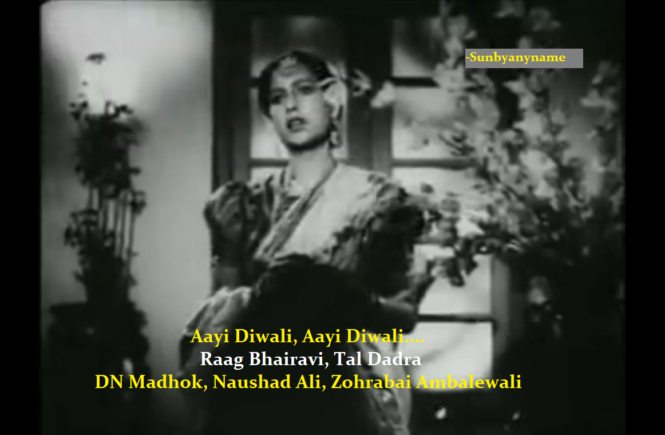Raaga Based Song of the Day: Aayi diwali, aayi diwali…. Raag Bhairavi, Tal Dadra Finally on the day of the Diwali today, 07 Nov 2018, I have the hundredth song in my Raaga Based Songs series. 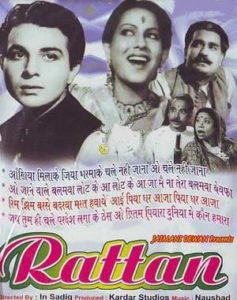 This song is from the 1944 movie Rattan that was an Abdul Rashid Kardar production that was directed by M Sadiq and starred Swaran Lata and Karan Dewan. Here is the story in brief to understand the song: Govind (Karan Dewan) and Gauri (Swaran Lata) are childhood friends and are in love. But both are from different castes and hence their marriage is not possible in those social times. One day Gauri is married off to a person who is much older to her, by keeping him in dark. Gauri is seen pining for Govind in this song. This is the ninth time I am taking up a song in this raaga. We have completed ninety-five days of Raaga Based Songs of the Day. Our first post in the series was titled ‘Raaga Based Song Of The Day #1’ and the song was a Mohammad Rafi and Lata Mangeshkar song from the 1970 Shakti Samanta movie Pagla Kahin Ka: Tum mujhe youn bhula na paoge. It is in Raag Jhinjhoti, Tal Kaherava. Our ninety-eighth post or the last post here was titled ‘Raaga Based Song Of The Day #99‘ and the song was a Mohammad Rafi song from the 1963 Brij movie Ustadon Ke Ustad starring Praddep Kumar, Shakila, Ashok Kumar and Sheikh Mukhtar: Sau baar janam lenge sau baar fanaa honge. It is in Raag Kaushik Kanada, Tal Kaherava. This blog has a number of posts on Raaga based songs in Hindi movies titled similarly; for example: ‘The Best Raaga Based Songs in Hindi Movies – Raaga Jhinjhoti – Part I‘. In the last ninety-eight days of sharing Raaga based songs of the day, I have given you songs based on Raag Jhinjhoti, Gara, Bhimpalasi, Madhuvanti, Shivaranjani, Bihag, Pahadi, Sarang, Pilu, Bhairavi, Khammaj, Charukesi, Kalyan or Yaman, Desh, Malgunji, Kirwani, Kedar, Bageshri, Megh Malhar, Bhupali, Ahir Bhairav, Malkaush, Mand, Adana, Kafi, Rageshri, Jaunpuri, Tilang, Janasammohini, Chayanat, Shuddha Kalyan, Gaur Sarang, Jogiya, Asavari, Maru Bihag, Durga, Lalit, Puria Dhanashri, Bhinna Sahdja, Sohani, Multani, Patdeep, Jaijaiwanti, Tilak Kamod, Hemant, Basant Mukhari, Gujri Todi, Kalavati, Hamir, Bhatiyar, Gawati, Shyam Kalyan, Gorakh Kalyan, Madhamat Sarang, Manj Khammaj, Darbari Kanada, Vibhas, Shankara, Bahar, Nand, Mian Ki Malhar and Jog; making it a total of 62 raagas. The raagas that have been repeated so far are Pahadi, the raaga of my home place in the Himalayas, Maru Bihag, Raag Kirwani, Jhinjhoti, Bhairavi, Gara, Basant Mukhari, Malkauns, Bhairavi, Mand, Sohani, Madhuvanti, Shivaranjani and Adana. Today, I am giving you a song in Raag Bhairavi, the Queen of all Raagas for the ninth time. The song, as I said earlier, is from the 1944 movie Rattan, an Abdul Rashid Kardar production directed by M Sadiq, which starred Swaran Lata and Karan Dewan. The song Aayi Diwali, Aayi Diwali was penned by DN Madhok and composed by Naushad. The songs of the movie made Naushad so famous that he started charging Rupees 25000 per movie. This was about one third of the production cost of the movie at that time. It is another fact that Swaran Lata, in an interview with Pakistan Television, claimed that the composition of this song was done by DN Madhok himself. The songs of the movie also made both the female playback singers Zohrabai Ambalewali and Amirbai Karnataki very famous. Here is a list of songs of the movie; the last song (duet) was equally popular:
This song is from the 1944 movie Rattan that was an Abdul Rashid Kardar production that was directed by M Sadiq and starred Swaran Lata and Karan Dewan. Here is the story in brief to understand the song: Govind (Karan Dewan) and Gauri (Swaran Lata) are childhood friends and are in love. But both are from different castes and hence their marriage is not possible in those social times. One day Gauri is married off to a person who is much older to her, by keeping him in dark. Gauri is seen pining for Govind in this song. This is the ninth time I am taking up a song in this raaga. We have completed ninety-five days of Raaga Based Songs of the Day. Our first post in the series was titled ‘Raaga Based Song Of The Day #1’ and the song was a Mohammad Rafi and Lata Mangeshkar song from the 1970 Shakti Samanta movie Pagla Kahin Ka: Tum mujhe youn bhula na paoge. It is in Raag Jhinjhoti, Tal Kaherava. Our ninety-eighth post or the last post here was titled ‘Raaga Based Song Of The Day #99‘ and the song was a Mohammad Rafi song from the 1963 Brij movie Ustadon Ke Ustad starring Praddep Kumar, Shakila, Ashok Kumar and Sheikh Mukhtar: Sau baar janam lenge sau baar fanaa honge. It is in Raag Kaushik Kanada, Tal Kaherava. This blog has a number of posts on Raaga based songs in Hindi movies titled similarly; for example: ‘The Best Raaga Based Songs in Hindi Movies – Raaga Jhinjhoti – Part I‘. In the last ninety-eight days of sharing Raaga based songs of the day, I have given you songs based on Raag Jhinjhoti, Gara, Bhimpalasi, Madhuvanti, Shivaranjani, Bihag, Pahadi, Sarang, Pilu, Bhairavi, Khammaj, Charukesi, Kalyan or Yaman, Desh, Malgunji, Kirwani, Kedar, Bageshri, Megh Malhar, Bhupali, Ahir Bhairav, Malkaush, Mand, Adana, Kafi, Rageshri, Jaunpuri, Tilang, Janasammohini, Chayanat, Shuddha Kalyan, Gaur Sarang, Jogiya, Asavari, Maru Bihag, Durga, Lalit, Puria Dhanashri, Bhinna Sahdja, Sohani, Multani, Patdeep, Jaijaiwanti, Tilak Kamod, Hemant, Basant Mukhari, Gujri Todi, Kalavati, Hamir, Bhatiyar, Gawati, Shyam Kalyan, Gorakh Kalyan, Madhamat Sarang, Manj Khammaj, Darbari Kanada, Vibhas, Shankara, Bahar, Nand, Mian Ki Malhar and Jog; making it a total of 62 raagas. The raagas that have been repeated so far are Pahadi, the raaga of my home place in the Himalayas, Maru Bihag, Raag Kirwani, Jhinjhoti, Bhairavi, Gara, Basant Mukhari, Malkauns, Bhairavi, Mand, Sohani, Madhuvanti, Shivaranjani and Adana. Today, I am giving you a song in Raag Bhairavi, the Queen of all Raagas for the ninth time. The song, as I said earlier, is from the 1944 movie Rattan, an Abdul Rashid Kardar production directed by M Sadiq, which starred Swaran Lata and Karan Dewan. The song Aayi Diwali, Aayi Diwali was penned by DN Madhok and composed by Naushad. The songs of the movie made Naushad so famous that he started charging Rupees 25000 per movie. This was about one third of the production cost of the movie at that time. It is another fact that Swaran Lata, in an interview with Pakistan Television, claimed that the composition of this song was done by DN Madhok himself. The songs of the movie also made both the female playback singers Zohrabai Ambalewali and Amirbai Karnataki very famous. Here is a list of songs of the movie; the last song (duet) was equally popular:
- “Akkhiyan Milake ” – Zohrabai Ambalawali
- “Rimjhim Barse Badarwa” – Zohrabai Ambalawali
- “Hindustan Ke Hum Hain” – Mohammad Rafi
- “Milke Bichhad Gayii Akkhiyan” – Amirbai Karnataki
- “Jab Tum Hi Chale Pardes Laga Kar Theis” -Karan Dewan
- “O janewale Balamwa” – Amirbai Karnataki and Shyam Kumar
- “Jab Tum Hi Chale Pardes Laga Kar Theis”
- “Pardesi Balma Baadal Aaya”
- “Sawan Ke Baadalo Unn Se Yeh Jaa Kaho”- Zohrabai Ambalewali and Karan Dewan
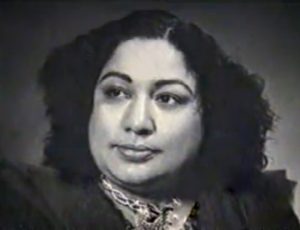 Zohrabai Ambalewali was from Ambala in Punjab. She was a classical singer of Hindustani Music trained under Ghulam Hussain Khan and Ustad Nasir Hussain Khan. Subsequently, she joined the Agra Gharana. She started singing at All India Radio at the age of 13. Eventually she made her Hindi film debut as a playback singer with film Daku Ki Ladki (1933) with music by Pransukh Nayak. After initial years in Lahore-based film industry, she shifted to Bombay. As already mentioned, the movie Rattan’s songs made her famous. Some of the popular songs of Zohrabai Ambalewali are: Aankhon mein intezaar ki duniya liye huye (Caravan 1944), Ho meri baali umariya saanwariya (Nateeja 1947), Pardesi baalma saawan aaya (Rattan 1944), Rut rangeeli aayi chandini chhayi (Mirza Sahiban 1947), Shayad woh jaa rahe hain chhupkar meri nazar se (Mela 1948, Shakeel Badayuni), Suno ji pyaari kayaliya bole (Sanyasi 1945, also with Naushad), Udhan khatole pe udh jaayun (Anmol Ghadi 1946, Naushad), Ye raat phir na aayegi (with Rajkumari Dubey in Mahal 1949).
Zohrabai Ambalewali was from Ambala in Punjab. She was a classical singer of Hindustani Music trained under Ghulam Hussain Khan and Ustad Nasir Hussain Khan. Subsequently, she joined the Agra Gharana. She started singing at All India Radio at the age of 13. Eventually she made her Hindi film debut as a playback singer with film Daku Ki Ladki (1933) with music by Pransukh Nayak. After initial years in Lahore-based film industry, she shifted to Bombay. As already mentioned, the movie Rattan’s songs made her famous. Some of the popular songs of Zohrabai Ambalewali are: Aankhon mein intezaar ki duniya liye huye (Caravan 1944), Ho meri baali umariya saanwariya (Nateeja 1947), Pardesi baalma saawan aaya (Rattan 1944), Rut rangeeli aayi chandini chhayi (Mirza Sahiban 1947), Shayad woh jaa rahe hain chhupkar meri nazar se (Mela 1948, Shakeel Badayuni), Suno ji pyaari kayaliya bole (Sanyasi 1945, also with Naushad), Udhan khatole pe udh jaayun (Anmol Ghadi 1946, Naushad), Ye raat phir na aayegi (with Rajkumari Dubey in Mahal 1949).
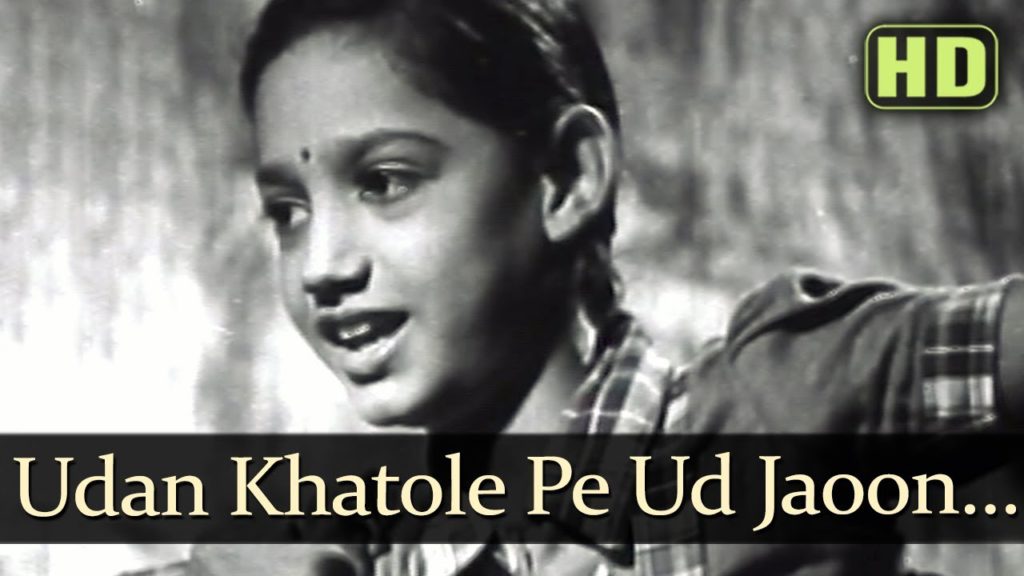
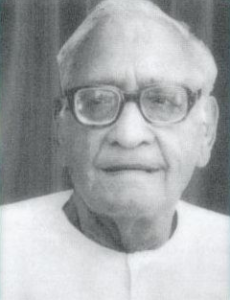 Lets take up the lyricist DN Madhok at this stage. Just as Zohrabai Amablewali was one of the first generation of female playback singers, Dina Nath Madhok was amongst the first generation of lyricists (1930s to 1950s). Kidar Sharma and Kavi Pradeep were the others. So fine was his art that he earned himself the sobriquet of Mahakavi Madhok. He started his career with the 1932 movie Radhey Sham and ended up penning about 800 songs. In addition he wrote screenplays and directed about 17 films including Baghdad Ka Chor (1934), Mirza Sahiban (1939), Biwamangal (1954) and Naata (1955). Here are some of my favourite songs penned by him: Aa ja balmaa raat andheri dar laage and Mere mundere na bol (Suraiya in 1947 movie Parwana), Aayi diwali aayi diwali (Zohrabai Ambalewali in 1944 movie Rattan), Beimaan tore nainva nindiya na aaye (Lata Mangeshkar in 1951 movie Taraana), Ham aankh macholi khelenge (Noorjahan, Khandan 1942), Ishq ka dard sohana (Vatsala Kumthekar, Ishaara 1942), Jab tum hi chale pardes laga ke thes (Karan Dewan, Rattan 1944), Jhuthe hain sab sapne suhaane (Manju, Rattan 1944), Kaagaz ki meri naav aur duur kinaara hai (Mukesh Suraiya, Do Dil 1947), Khamosh nigaahen ye sunaati hain kahaani (SD Batish, Daasi 1944), Madhukar Shyam hamare chor, Nis din barsat nain hamaare and Rain gayi ab huaa savera (KL Saigal, Bhakt Surdas 1942), Madhur Madhur ga re manwa and Panchhi bawra (Khursheed, Bhakt Surdas 1942), Meri zindagi mein tum kyun aaye (Suraiya, Goonj 1952), Mohe mera bachpan laa de (With Shakeel Badayuni in Kajal 1948; song sung by Suraiya), More sainya ji ne bheji chunari (Zohrabai Ambalewali, Pehle Aap 1944), Mohabbat ne kaise diye hamako dhokhe (Lata Mangeshkar, Oot Pataang 1955), Naa thamate hain aansu naa rukte hain naale (Mohammad Rafi, Meena Bazaar 1950), Naino mein naina mat dalo, and Pardesi baalma baadal aaya (Zohrabai Ambalewali, Jeewan 1944), O jaanewale baalmwa laut ke aa (Shaam Kumar and Amirbai Karnataki, Rattan 1944), Panghat pe more Shyam bajaaye muraliya (CH Atma, Bilwamangal 1954), Rum jhum barse baadarva (Amirbai Karnataki, Rattan 1944), Sawan ke baadlo unase ye jaa kaho (Zohrabai Ambalewali, Rattan 1944), Taare wahin hain chand wahin hai (Lata Mangeshkar, Anmol Ratan 1950), Tuut gaye sab sapne mere (KL Saigal, Parwana 1947), and Wo din kahan gaye bataa (Lata Mangeshkar, Taraana 1951).
Lets take up the lyricist DN Madhok at this stage. Just as Zohrabai Amablewali was one of the first generation of female playback singers, Dina Nath Madhok was amongst the first generation of lyricists (1930s to 1950s). Kidar Sharma and Kavi Pradeep were the others. So fine was his art that he earned himself the sobriquet of Mahakavi Madhok. He started his career with the 1932 movie Radhey Sham and ended up penning about 800 songs. In addition he wrote screenplays and directed about 17 films including Baghdad Ka Chor (1934), Mirza Sahiban (1939), Biwamangal (1954) and Naata (1955). Here are some of my favourite songs penned by him: Aa ja balmaa raat andheri dar laage and Mere mundere na bol (Suraiya in 1947 movie Parwana), Aayi diwali aayi diwali (Zohrabai Ambalewali in 1944 movie Rattan), Beimaan tore nainva nindiya na aaye (Lata Mangeshkar in 1951 movie Taraana), Ham aankh macholi khelenge (Noorjahan, Khandan 1942), Ishq ka dard sohana (Vatsala Kumthekar, Ishaara 1942), Jab tum hi chale pardes laga ke thes (Karan Dewan, Rattan 1944), Jhuthe hain sab sapne suhaane (Manju, Rattan 1944), Kaagaz ki meri naav aur duur kinaara hai (Mukesh Suraiya, Do Dil 1947), Khamosh nigaahen ye sunaati hain kahaani (SD Batish, Daasi 1944), Madhukar Shyam hamare chor, Nis din barsat nain hamaare and Rain gayi ab huaa savera (KL Saigal, Bhakt Surdas 1942), Madhur Madhur ga re manwa and Panchhi bawra (Khursheed, Bhakt Surdas 1942), Meri zindagi mein tum kyun aaye (Suraiya, Goonj 1952), Mohe mera bachpan laa de (With Shakeel Badayuni in Kajal 1948; song sung by Suraiya), More sainya ji ne bheji chunari (Zohrabai Ambalewali, Pehle Aap 1944), Mohabbat ne kaise diye hamako dhokhe (Lata Mangeshkar, Oot Pataang 1955), Naa thamate hain aansu naa rukte hain naale (Mohammad Rafi, Meena Bazaar 1950), Naino mein naina mat dalo, and Pardesi baalma baadal aaya (Zohrabai Ambalewali, Jeewan 1944), O jaanewale baalmwa laut ke aa (Shaam Kumar and Amirbai Karnataki, Rattan 1944), Panghat pe more Shyam bajaaye muraliya (CH Atma, Bilwamangal 1954), Rum jhum barse baadarva (Amirbai Karnataki, Rattan 1944), Sawan ke baadlo unase ye jaa kaho (Zohrabai Ambalewali, Rattan 1944), Taare wahin hain chand wahin hai (Lata Mangeshkar, Anmol Ratan 1950), Tuut gaye sab sapne mere (KL Saigal, Parwana 1947), and Wo din kahan gaye bataa (Lata Mangeshkar, Taraana 1951).
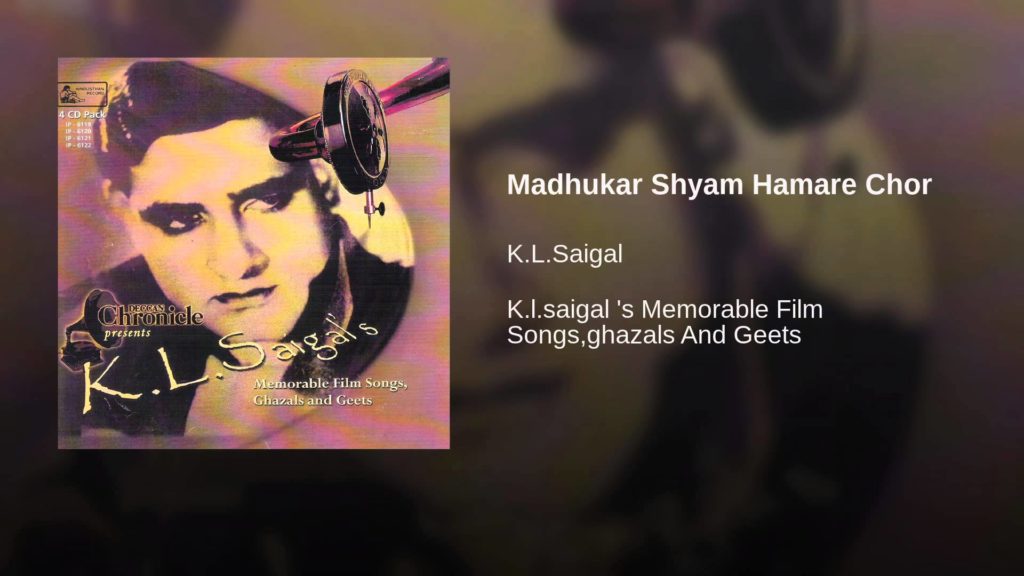
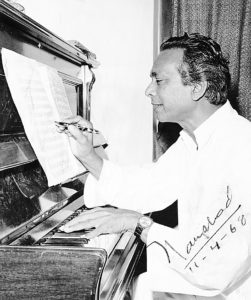
Naushad Ali, the composer, lived between 25 Dec 1919 to 05 May 2006. He won only one Filmfare Award, for the music and songs of the 1952 Vijay Bhatt movie Baiju Bawra. However, he could have won many including for Mughal-e-Azam. Eventually, he was conferred with the highest, that is, Dadasaheb Phalke Award in 1982 and Padma Bhushan in 1992. He is credited with having brought in Raaga Based Songs in the movies and Baiju Bawra is a fine example of that. Various singers and lyricists (especially Shakeel Badayuni) looked up to him as a guide and mentor. For example, he encouraged Mukesh to have his distinctive style of singing rather than imitate KL Saigal. He launched the careers of quite a few of them such as Zohrabai Ambalewali and Uma Devi. As far as my favourite songs of Naushad are concerned, I have penned volumes in this blog on them. As an example, just go through: ‘The Best Of Old Hindi Songs – Rafi, Shakeel, Naushad and Dilip Kumar Together’.
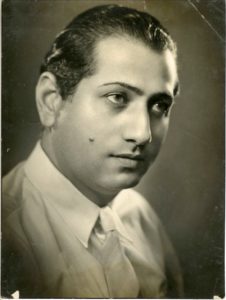
Before we take up the song, lets learn a little about Abdul Rashid Kardar, the producer of this movie from where the song has been taken. He was the pioneer in establishing film industry in Bhati Gate, Lahore (later Pakistan). In 1924, the first silent film (11 years after Dadasaheb Phalke made his first silent movie: Raja Harishchandra), The Daughters of Today was released in Lahore at a time when the city only had nine operational cinema houses. Most of the films shown in theatres in Lahore were either made in Bombay or Calcutta, besides ones made in Hollywood or London. The Daughters of Today was the brain-child of GK Mehta, a former officer with the North-Western Railway, who had imported a camera into the country for this very project from London. He asked Kardar to assist him as an assistant director on the project and ended up giving Kardar his début role in his film as an actor. Muhammad Ismail, his friend and fellow calligraphist, accompanied Kardar in the making of the film. Kardar shifted to Calcutta in 1930 and after working in various production houses, he made his own Kardar Studios in 1940 (he shifted to Bombay in 1937) and started making films under the banner Kardar Productions. His 1946 film Shahjehan starred KL Saigal and the songs were by Majrooh (debut movie) and Naushad Ali. He worked with Naushad in a number of movies including the unforgettable Dil Diya Dard Liya starring Dilip Kumar, Waheeda Rehman and Pran.

M Sadiq, the director of the highly successful movie Rattan from where this song has been taken was born on 10 Mar 1910 in Lahore and died on 03 Oct 1971 in Lohore. He was a director, writer and producer. Some of the other movies that he directed are: Jeewan (1944), Dak Bangla (1947), Anmol Ratan (1950), Shabaab (1954), Chaudhvinh Ka Chand (1960), Full Moon (1961), Taj Mahal (1963), Bahu Begum (1967) and Noorjehan (1967).
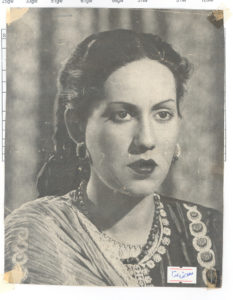
Swaran Lata, the actress on whom this song is picturised, was born in a Siyal Khatri Sikh family in Rawalpindi. Her debut movie was the 1942 movie Awaaz. She married Nazir Ahmed, a famous actor, director and producer at that time. She converted to Islam at that time and assumed the name of Saeeda Bano. At the time of partition of India in 1947, she migrated to Pakistan with her husband after leaving everything they owned in Bombay. They started the Pakistani Film Industry from a scratch. By the time she shifted to Pakistan, in five years she had acted in as many as 16 Hindi movies. Her first movie in Pakistan was the 1948 movie Sachai. She was known as the Tragedy Queen much before Meena Kumari was so dubbed. This was mainly due to her emotional dialogue delivery. It is a delight to see her enact the song: Aayi Diwali Aayi Diwali. This song, as I told you, is in Raag Bhairavi, Tal Kaherava. 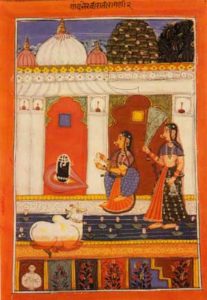 Raag Bhairavi is the basic raag of the Bhairavi Thaat. Bhairavi makes use of all the komal swars, Rishabh, Gandhar, Dhaivat, Nishad. When singing compositions in Bhairavi raag, the singers however take liberty to use all the 12 swars. Bhairavi raag is named after the shakti or feminine aspect of the cosmic life force, which is personified as a consort to Lord Shiva. Bhairavi is a powerful raag filled with devotion and compassion. Its Jati is Sampurna – Sampurna, which means all seven swar (heptatonic) both in Aaroha and Avaroha. I have already told you that in a concert Bhairavi is usually the concluding raaga since it is supposed to cure mistakes of the earlier performances. Hence, if a concert has started at night (which is usually the case), Bhairavi would be played in the wee hours of the morning. A pleasant sobering atmosphere full of love and piety is created with this raag and one feels so close to the Supreme. Its compositions include several Thumris, Bhajans, Ghazals, Songs etc. Since it is an ocean of immense possibilities the melodic combinations can include all the twelve notes with skill. I am not giving you again a list of songs composed in Raag Bhairavi as I have given this adequate number of times. As far as Tal Dadra is concerned, Tal Dadra derives its name from Dadra style of singing prevalent in Dadra. It is a six or three beat Tal: Clap, 2, 3, Wave, 2, 3; that is two vibhags of three matras each. The theka is: Dhaa Dhin Naa Dhaa Tin Naa I gave you a song in this Tal and Raag Bhimpalasi as m 3rd song in the series: Maine chand aur sitaaron ki tamanna ki thi. After that I have given you several songs in the Tal such as: Tere sur aur mere geet (Bihag), Aaj ki raat piya dil na todo (Pahadi), Beqasi hadd se jab guzr jaay (Desh and Khammaj), Dukh bhare din beete re bhaiya (Megh Malhar), Kesariya Balma (Nand), Kuchh aur zamaana kehta hai (Gaur Sarang), Taqdeer ka fasaana (Desh), Bhooli hui yaadon (Kalyan), Benuravvat bewafa (Shankara), Jhumati chali hawa (Sohani), Dil Ke jharokhe mein (Shivaranjani), and Paan khaayo sainya hamaro (Kalyan). However, in the eight songs based on Raag Bhairavi that I have given you, there has never been one in this Tal; most of these have been in Tal Kaherava. Before we actually take up the song, first, lets take up the value added learning of today. From the last eighteen times we started learning about some of the leading personalities in Indian Classical Music or Shastriya Sangeet. The first one that we took up was Ustaad Asad Ali Khan, the finest Rudra Veena player in the country. Then we took up Pandit Hari Parsad Chaurasia, the greatest Bansuri player in the country. Then we talked about Ali Akbar Khan, the greatest Sarod player in the country. Then we took up Pandit Ravi Shankar, the greatest Sitar player in the world. Then we took up the greatest classical singer in the country (of Carnatic tradition): MS Subbulakshmi. Then, we took up the greatest classical singer in the country (of Hindustani tradition): Pandit Bhimsen Joshi. Then, we learnt about the Shehnai maestro Ustad Bismillah Khan. Then, we learnt about Annapurna Devi, a great Surbahar (bass sitar) player of Hindustani Classical Music. Thereafter, we took up Pandit Shiv Kumar Sharma, the grestest Santoor player in the country. Then we learnt a little more about Ustaad Alla Rakha Qureshi or simply Alla Rakha, the Tabla Maestro and father of Ustaad Zakir Hussain. Then we learnt about the master and one of the pioneers of fusion: Anand Shankar. Then we learnt about a Veena player who was also a great filmmaker: Sundaram Balachander. Then we learnt about Sarod Player Ustad Amjad Ali Khan. And then we learnt about Ustaad Zakir Hussain, the Tabla maestro. Then we learnt about Sitar Player and Composer Anoushka Shankar. And then we covered vocalist Pandit Jasraj. We then covered violinist L Subramaniam followed by Sitarists Ustaad Vilayat Khan and Nikhil Banerjee.
Raag Bhairavi is the basic raag of the Bhairavi Thaat. Bhairavi makes use of all the komal swars, Rishabh, Gandhar, Dhaivat, Nishad. When singing compositions in Bhairavi raag, the singers however take liberty to use all the 12 swars. Bhairavi raag is named after the shakti or feminine aspect of the cosmic life force, which is personified as a consort to Lord Shiva. Bhairavi is a powerful raag filled with devotion and compassion. Its Jati is Sampurna – Sampurna, which means all seven swar (heptatonic) both in Aaroha and Avaroha. I have already told you that in a concert Bhairavi is usually the concluding raaga since it is supposed to cure mistakes of the earlier performances. Hence, if a concert has started at night (which is usually the case), Bhairavi would be played in the wee hours of the morning. A pleasant sobering atmosphere full of love and piety is created with this raag and one feels so close to the Supreme. Its compositions include several Thumris, Bhajans, Ghazals, Songs etc. Since it is an ocean of immense possibilities the melodic combinations can include all the twelve notes with skill. I am not giving you again a list of songs composed in Raag Bhairavi as I have given this adequate number of times. As far as Tal Dadra is concerned, Tal Dadra derives its name from Dadra style of singing prevalent in Dadra. It is a six or three beat Tal: Clap, 2, 3, Wave, 2, 3; that is two vibhags of three matras each. The theka is: Dhaa Dhin Naa Dhaa Tin Naa I gave you a song in this Tal and Raag Bhimpalasi as m 3rd song in the series: Maine chand aur sitaaron ki tamanna ki thi. After that I have given you several songs in the Tal such as: Tere sur aur mere geet (Bihag), Aaj ki raat piya dil na todo (Pahadi), Beqasi hadd se jab guzr jaay (Desh and Khammaj), Dukh bhare din beete re bhaiya (Megh Malhar), Kesariya Balma (Nand), Kuchh aur zamaana kehta hai (Gaur Sarang), Taqdeer ka fasaana (Desh), Bhooli hui yaadon (Kalyan), Benuravvat bewafa (Shankara), Jhumati chali hawa (Sohani), Dil Ke jharokhe mein (Shivaranjani), and Paan khaayo sainya hamaro (Kalyan). However, in the eight songs based on Raag Bhairavi that I have given you, there has never been one in this Tal; most of these have been in Tal Kaherava. Before we actually take up the song, first, lets take up the value added learning of today. From the last eighteen times we started learning about some of the leading personalities in Indian Classical Music or Shastriya Sangeet. The first one that we took up was Ustaad Asad Ali Khan, the finest Rudra Veena player in the country. Then we took up Pandit Hari Parsad Chaurasia, the greatest Bansuri player in the country. Then we talked about Ali Akbar Khan, the greatest Sarod player in the country. Then we took up Pandit Ravi Shankar, the greatest Sitar player in the world. Then we took up the greatest classical singer in the country (of Carnatic tradition): MS Subbulakshmi. Then, we took up the greatest classical singer in the country (of Hindustani tradition): Pandit Bhimsen Joshi. Then, we learnt about the Shehnai maestro Ustad Bismillah Khan. Then, we learnt about Annapurna Devi, a great Surbahar (bass sitar) player of Hindustani Classical Music. Thereafter, we took up Pandit Shiv Kumar Sharma, the grestest Santoor player in the country. Then we learnt a little more about Ustaad Alla Rakha Qureshi or simply Alla Rakha, the Tabla Maestro and father of Ustaad Zakir Hussain. Then we learnt about the master and one of the pioneers of fusion: Anand Shankar. Then we learnt about a Veena player who was also a great filmmaker: Sundaram Balachander. Then we learnt about Sarod Player Ustad Amjad Ali Khan. And then we learnt about Ustaad Zakir Hussain, the Tabla maestro. Then we learnt about Sitar Player and Composer Anoushka Shankar. And then we covered vocalist Pandit Jasraj. We then covered violinist L Subramaniam followed by Sitarists Ustaad Vilayat Khan and Nikhil Banerjee. 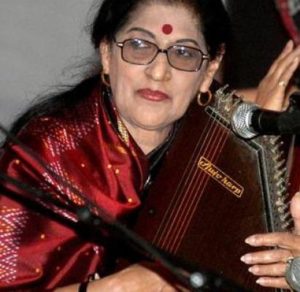 Tonight, we shall take up the great vocalist Kishori Amonkar. She lived between 10 Apr 1931 and 03 Apr 2017. She was a leading Indian vocalist of the Jaipur Gharana. She was a performer of the classical genre khyal and the light classical genres thumri and bhajan. Amonkar trained under her mother, classical singer Mogubai Kurdikar also from the Jaipur gharana, but she experimented with a variety of vocal styles in her career. Amonkar’s later work in light music reformed her classical singing and she modified her Jaipur gharana performance style by applying features from other gharanas. She has been both praised and criticized for pushing the boundaries of the Jaipur tradition. She was a romanticist and her approach prioritized emotional expression over tradition, so she often departed from the Jaipur gharana’s rhythmic, melodic, and structural traditions. Amonkar received several of India’s national awards and civilian honours, including the Padma Bhushan, in 1987, and Padma Vibhushan in 2002. She was awarded the Sangeet Natak Akademi Award for 1985 and the Sangeet Natak Akademi Fellowship for 2009. She was awarded the prestigious Dr. T. M. A. Pai Outstanding Konkani Award in 1991. In 2016, she was one of seven recipients of the M.S. Subbulakshmi Award for classical music. Returning to the song now. The song, as I told you, is from the 1944 M Sadiq movie Rattan that proved the genius of one of Hindi movies greatest music directors: Naushad Ali. He is the one who for the first time introduced Raaga based songs in Hindi movies. His selection of Bhairavi here is masterly: an atmosphere of total love and piety. M Sadiq has followed it up with the lamps and lamp-bearing female dancers. However, there is emptiness in the eyes of Swaran Lata when she asks who should he dance with since her consort (Karan Dewan) is not there. She mourns about life slipping by without them being together. The matching lyrics rendered by DN Madhok do touch your heart and would apply to anyone of us. Ladies and gentlemen, please enjoy in Raag Bhairavi Tal Dadra, Zohrabai Ambalewali sing a composition of Naushad on the lyrics of DN Madhok in the 1944 M Sadiq movie Rattan (produced by AR Kardar) starring Swaran Lata and Karan Dewan: Aayi diwali, aayi diwali…..
Tonight, we shall take up the great vocalist Kishori Amonkar. She lived between 10 Apr 1931 and 03 Apr 2017. She was a leading Indian vocalist of the Jaipur Gharana. She was a performer of the classical genre khyal and the light classical genres thumri and bhajan. Amonkar trained under her mother, classical singer Mogubai Kurdikar also from the Jaipur gharana, but she experimented with a variety of vocal styles in her career. Amonkar’s later work in light music reformed her classical singing and she modified her Jaipur gharana performance style by applying features from other gharanas. She has been both praised and criticized for pushing the boundaries of the Jaipur tradition. She was a romanticist and her approach prioritized emotional expression over tradition, so she often departed from the Jaipur gharana’s rhythmic, melodic, and structural traditions. Amonkar received several of India’s national awards and civilian honours, including the Padma Bhushan, in 1987, and Padma Vibhushan in 2002. She was awarded the Sangeet Natak Akademi Award for 1985 and the Sangeet Natak Akademi Fellowship for 2009. She was awarded the prestigious Dr. T. M. A. Pai Outstanding Konkani Award in 1991. In 2016, she was one of seven recipients of the M.S. Subbulakshmi Award for classical music. Returning to the song now. The song, as I told you, is from the 1944 M Sadiq movie Rattan that proved the genius of one of Hindi movies greatest music directors: Naushad Ali. He is the one who for the first time introduced Raaga based songs in Hindi movies. His selection of Bhairavi here is masterly: an atmosphere of total love and piety. M Sadiq has followed it up with the lamps and lamp-bearing female dancers. However, there is emptiness in the eyes of Swaran Lata when she asks who should he dance with since her consort (Karan Dewan) is not there. She mourns about life slipping by without them being together. The matching lyrics rendered by DN Madhok do touch your heart and would apply to anyone of us. Ladies and gentlemen, please enjoy in Raag Bhairavi Tal Dadra, Zohrabai Ambalewali sing a composition of Naushad on the lyrics of DN Madhok in the 1944 M Sadiq movie Rattan (produced by AR Kardar) starring Swaran Lata and Karan Dewan: Aayi diwali, aayi diwali…..
आई दीवाली, आई दीवाली – २ दीपक संग नाचे पतंगा मैं किसके संग नाचूँ बताजा आई दीवाली, आई दीवाली … (बचपन जवानी संग नाचके चला गया अब नाचे जवानी बुढ़ापे संग वो दिन आ गया ) – २ अब नाचे जवानी बुढ़ापे संग वो दिन आ गया बिछड़े हुए साथी ज़रा आ मैं किसके संग नाचूं बताजा आई दीवाली, आई दीवाली … (किसको गुमान था वो दिन भी गुज़र जायेंगे और एक बार जाके वो फिर लौट के ना आयेंगे ) – २ बिछड़े हुए साथी ज़रा आ मैं किसके संग नाचूँ बताजा (आई दीवाली, आई दीवाली ) – २ दीपक संग नाचे पतंगा मैं किसके संग नाचूँ बताजा आई दीवाली, आई दीवाली …
https://youtu.be/rSRPU_yXOx4
https://youtu.be/rSRPU_yXOx
We have intended to learn about Raaga based music whilst we entertain ourselves with Raaga based songs. So, lets, once again, take stock of our collective learning so far:
- On the first day we learnt about the Raaga system devised by Pandit Vishnu Narayan Bhatkhande, which is the prevalent system in Hindustani Classical Music and based on ten Thaats.
- On the second day we learnt about Tal or Taal.
- On the third day we learnt about characteristics of Raagas that included Swar, Jati, Thaat, Arohana and Avarohana, Vadi, Samvadi and Pakad.
- On the fourth day, we learnt about Sargam.
- On the fifth day, we learnt about notations used in Indian classical music or simply Swar Lipi.
- On the sixth day, we learnt about the Ras (sentiments) that Raagas evoke.
- On the seventh day, we learnt about various types of Swar: Shuddha, Achal, Vikrut, Komal and Teevra.
- On the eighth day, we learnt the parts of a composition in Indian Classical Music.
- On the ninth day, we learnt the names of some of the popular instruments used in Indian Classical Music.
- On the tenth day, we learnt about the sources of names of Raagas.
- On the eleventh day, we learnt about why Bhairavi is the first raag to be taught to beginners and also why it is the last in a performance.
- On the twelfth day, we learnt about Khammaj Thaat.
- On the thirteenth day, we learnt about Tal Punjabi Theka or Sitarkhani.
- On the fourteenth day, we learnt about Alap.
- On the fifteenth day, we learnt about List of Raagas (Raagmala) in my favourite book: Sri Guru Granth Sahib.
- On the sixteenth day, we learnt about tips for raaga identification.
- On the seventeenth day, we learnt the basics of Gharana system.
- On the eighteenth day, we learnt about Filmi Sangeet.
- On the nineteenth day, we learnt about the commonest Tal in Raagas: Tintal.
- On the twentieth day, we learnt about the Kafi Thaat.
- On the twenty-first day, we learnt a little more in detail about the classification of Raagas.
- On the twenty-second day, we learnt the essential differences between Bhairavi and Bhairav.
- On the twenty-third day, we learnt a little more in detail about the Jati or Jaati of a raaga.
- On the twenty-fourth day, we learnt details of Thaat Bilawal, the most basic thaat in the Bhatkhande’s system of raagas.
- On the twenty-fifth day, we learnt about Tintal.
- On the twenty-sixth day, we learnt in detail about the Raaga – Samay linkage.
- On the twenty-seventh day, we learnt about Lehar.
- On the twenty-eighth day, we learnt about the history of the Hindustani Music.
- On the twenty-ninth day, we learnt about Dhrupad.
- On the thirtieth day, we learnt about Rupaktal that I was introduced to, a few months back, by my friend Anand Desai.
- On the thirty-first day, we learnt about Khayal.
- On the thirty-second day, we learnt about Thumri.
- On the thirty-third day, we learnt about Tappa.
- On the thirty-fourth day, we learnt about Tarana.
- On the thirty-fifth day, we learnt about Tal Dipchandi (Moghali).
- On the thirty-sixth day, we learnt about Tabla.
- On the thirty-seventh day, we learnt about Kirtan.
- On the thirty-eighth day, we learnt about Pakhawaj.
- On the thirty-ninth day, we learnt about Hori.
- On the fortieth day, we learnt about Dadra.
- On the forty-first day, we learnt about Kajri.
- On the forty-second day, we learnt about Chaiti.
- On the forty-third day, we learnt about Sarangi.
- On the forty-fourth day, we learnt about Shehnai.
- On the forty-fifth day, we learnt about Sarod.
- On the forty-sixth day, we learnt about Bansuri.
- On the forty-seventh day, we learnt about Ektal and Tanpura.
- On the forty-eighth day, we learnt about Veena.
- On the forty-ninth day, we repeated our learning of Veena with a small excitement added.
- On the fiftieth day, we learnt about Dilruba/Esraj.
- On the fifty-first day, we learnt about Jaltarang.
- On the fifty-second day we learnt about Qawwali.
- On the fifty-third day, we learnt about Sitar.
- On the fifty-fourth day, we learnt about Surbahar.
- On the fifty-fifth day, we learnt about Harmonium.
- On the fifty-sixth day, we learnt about Santoor.
- On the fifty-seventh day, we learnt about Swarmandal.
- On the fifty-eighth day, we learnt about the Shruti Box.
- On the fifty-ninth day, we learnt about Alankar.
- On the sixtieth day, we learnt about singing in Aakaar.
- On the sixty-first day, we learnt about the Classification of Indian Musical Instruments.
- On the sixty-second day, we learnt a little about Carnatic Music.
- On the sixty-third day, we learnt about Natya Shastra.
- On the sixty-fourth day, we learnt about evolution of musical instruments in India down the ages.
- On the sixty-fifth day, we learnt about Riyaaz.
- On the sixty-sixth day, we looked at a list of Raagas in Hindustani Classical Music.
- On the sixty-seventh day, we learnt about the health benefits of raagas.
- On the sixty-eighth day, we learnt a little more comprehensively about the moods and emotions that raagas evoke.
- On the sixty-ninth day, we learnt about a mobile application to help identify raagas.
- On the seventieth day, we learnt about Melakarta Raagas.
- On the seventy-first day, we learnt about Sangita Makarand.
- On the seventy-second day, we learnt about TaalMala an Android application for personalized accompaniment of musical instruments during Riyaaz or even during Concert.
- On the seventy-third day, we learnt about Indian Classical Ragas, an Android application for mobile phones.
- On the seventy-fourth day, we learnt about Saregama Classical, another application for Classical Raagas.
- On the seventy-fifth day, we learnt about a free online service available to learn Indian Classical Music.
- On the seventy-sixth day, we learnt about List of Hindustani Classical Musical Festivals in India and Abroad.
- On the seventy-seventh day, we learnt about List of Carnatic Musical Festivals in India and Abroad.
- On the seventy-eighth day, we learnt about Jhaptal.
- On the seventy-ninth day, we learnt about Ektal.
- On the eightieth day, we learnt about Tivra Tal.
- On the eighty-first day, we learnt about the greatest Rudra Veena player ever: Ustaad Asad Ali Khan.
- On the eighty-second day, we learnt about the greatest Bansuri player alive: Pandit Hariprasad Chaurasia.
- On the eighty-third day, we learnt about the best Sarod player in the country: Ustaad Ali Akbar Khan.
- On the eighty-fourth day, we learnt about the greatest Sitar player in the world: Pandit Ravi Shankar.
- On the eighty-fifth day, we learnt about the greatest Indian vocalist of Carnatic tradition: MS Subbulakshmi.
- On the eighty-sixth day, we not just learnt about the greatest vocalist of Hindustani tradition: Pandit Bhimsen Joshi but also learnt about Tal Hinch.
- On the eighty-seventh day, we learnt about the Shehnai maestro Ustaad Bismillah Khan.
- On the eighty-eighth day, we learnt about Annapurna Devi, the greatest Surbahar player in India.
- On the eighty-ninth day, we learnt about Pandit Shiv Kumar Sharma, the greatest Santoor Player in the country.
- On the ninetieth day, we learnt about Ustaad Alla Rakha, the Tabla maestro.
- On the ninety-first day, we learnt about Anand Shankar, the great fusion musician from Bengal.
- On the ninety-second day, we learnt about Sundaram Balachander, the great Veena player and film-maker.
- On the ninety-third day, we learnt about Ustaad Amjad Ali Khan, the great Sarod player.
- On the ninety-fourth day, we learnt about the Tabla maestro: Ustaad Zakir Hussain.
- On the ninety-fifth day, we learnt about the Sitar player and Composer: Anoushka Shankar.
- On the ninety-sixth day, we learnt about the Vocalist Pandit Jasraj.
- On the ninety-seventh day, we learnt about the great violinist L Subramaniam.
- On the ninety-eighth day, we learnt about one of the greatest sitarists: Ustaad Vilayat Khan.
- On the ninety-ninth day, we learnt about another great sitarist: Nikhil Banerjee.
- And today, on the hundredth day, we learnt about the great vocalist: Kioshori Amonkar.
There is much more still to be learnt and enjoyed. Please stay tuned!
